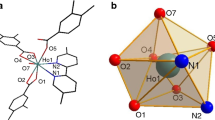Abstract
Modern textbooks dealing with the chemistry of the lanthanide elements state that the elemental lanthanides, with a few exceptions, dissolve in dilute aqueous acids with the formation of the trivalent lanthanide cation and hydrogen gas. One exception that has been reported is the red coloration imparted to dilute hydrochloric acid solutions containing a chip of dissolving samarium metal. This red coloration has been attributed to the divalent samarium cation. But careful observation of specimens of elemental lanthanides actually being dissolved in dilute acids may show unexpected results. For example, a faint brown coloration can sometimes be observed above a similarly dissolving chip of neodymium metal. There is nothing in the reported chemistry of neodymium that indicates a brown coloration under such circumstances, and the possibility of the formation of divalent neodymium cations is suggested by analogy. Also by analogy, the rapid disappearance of the brown coloration further suggests oxidation of the supposed divalent neodymium cations by hydrogen ions. To diminish the speed of the supposed oxidation reaction, the dissolution experiment may be repeated in a solution with a diminished concentration of hydrogen ions, as in a solution of a weak acid.
Mound Facility is operated by Monsanto Research Corporation for the U. S. Department of Energy under Contract No. DE-AC04-76-DP00053.
Access this chapter
Tax calculation will be finalised at checkout
Purchases are for personal use only
Similar content being viewed by others
References
G. L. Silver, J. Inorg. Nucl. Chem., 30, 1735 (1968).
G. L. Silver, P. W. Seabaugh, W. H. Smith, and R. R. Eckstein, Hydridic Nature of Rare Earth Preparations with Reducing Properties, USAEC Report MLM-1648 (August 8, 1969 ), 13 pp.
G. L. Silver, Further Studies on New Hydridic Rare Earth Compounds, USAEC Report MLM-1914 (May 16, 1972 ), 11 pp.
T. Moeller, The Chemistry of the Lanthanides, Reinhold Publishing Corp., New York, 1963, p. 64.
Author information
Authors and Affiliations
Editor information
Editors and Affiliations
Rights and permissions
Copyright information
© 1980 Plenum Press, New York
About this chapter
Cite this chapter
Silver, G.L. (1980). New Hydridic Rare Earth Compounds. In: McCarthy, G.J., Rhyne, J.J., Silber, H.B. (eds) The Rare Earths in Modern Science and Technology. Springer, Boston, MA. https://doi.org/10.1007/978-1-4613-3054-7_113
Download citation
DOI: https://doi.org/10.1007/978-1-4613-3054-7_113
Publisher Name: Springer, Boston, MA
Print ISBN: 978-1-4613-3056-1
Online ISBN: 978-1-4613-3054-7
eBook Packages: Springer Book Archive




